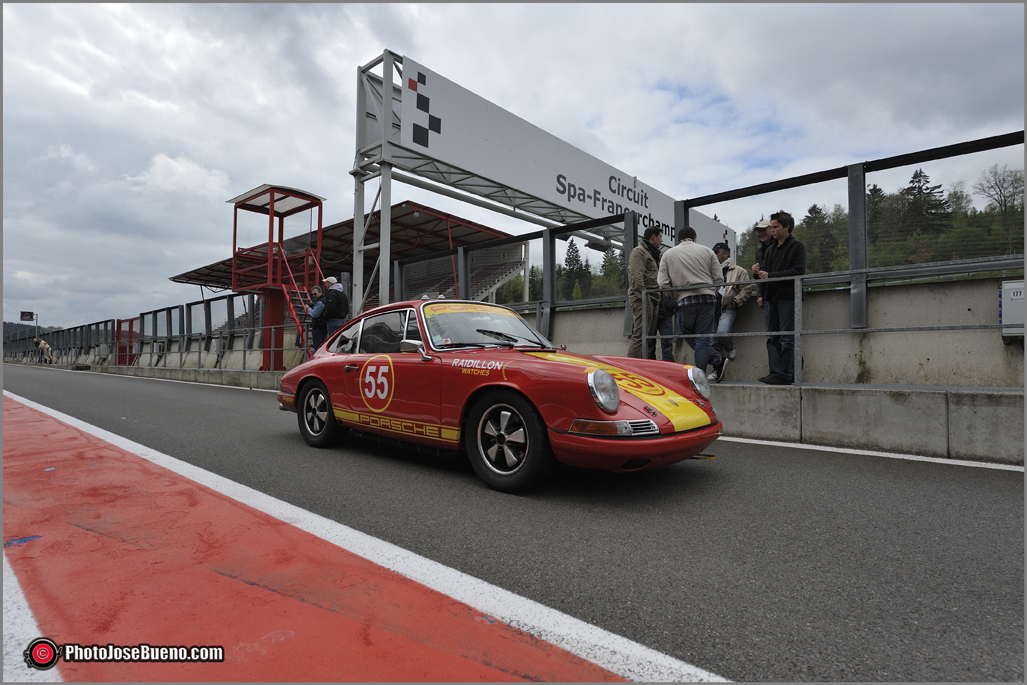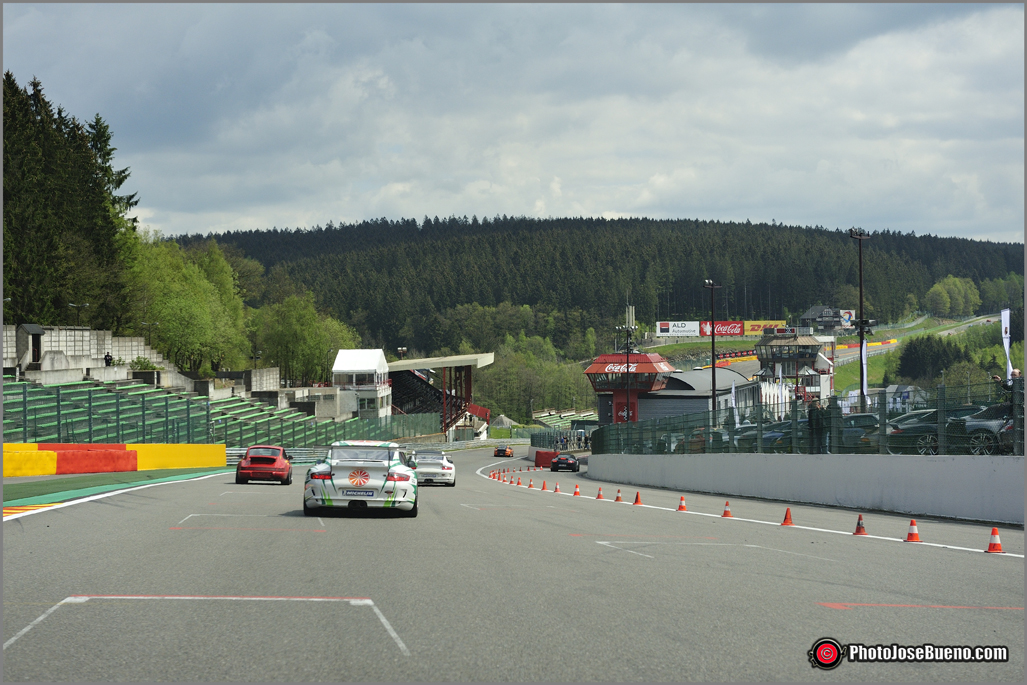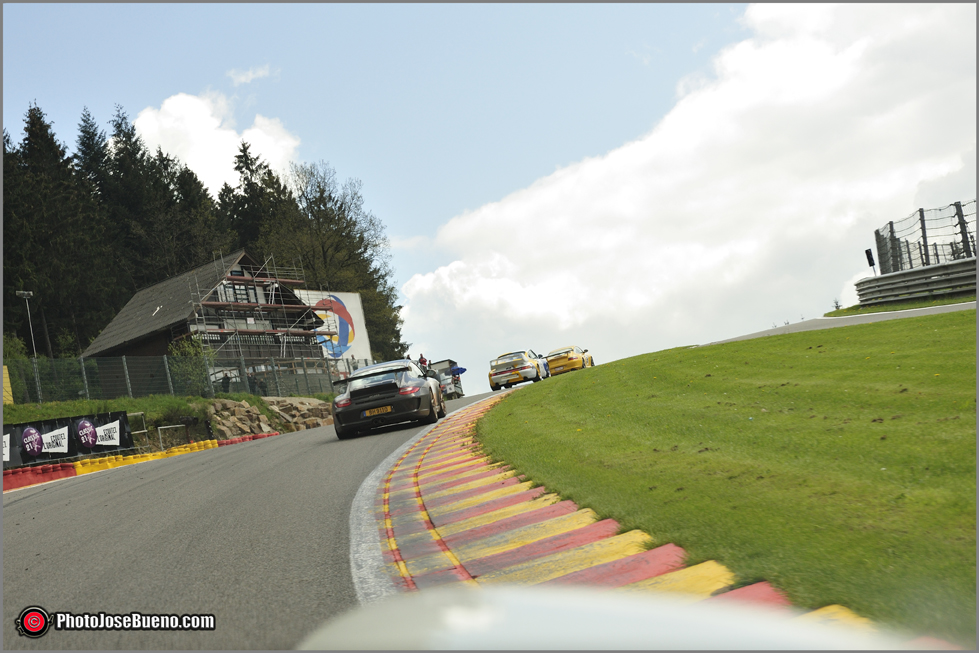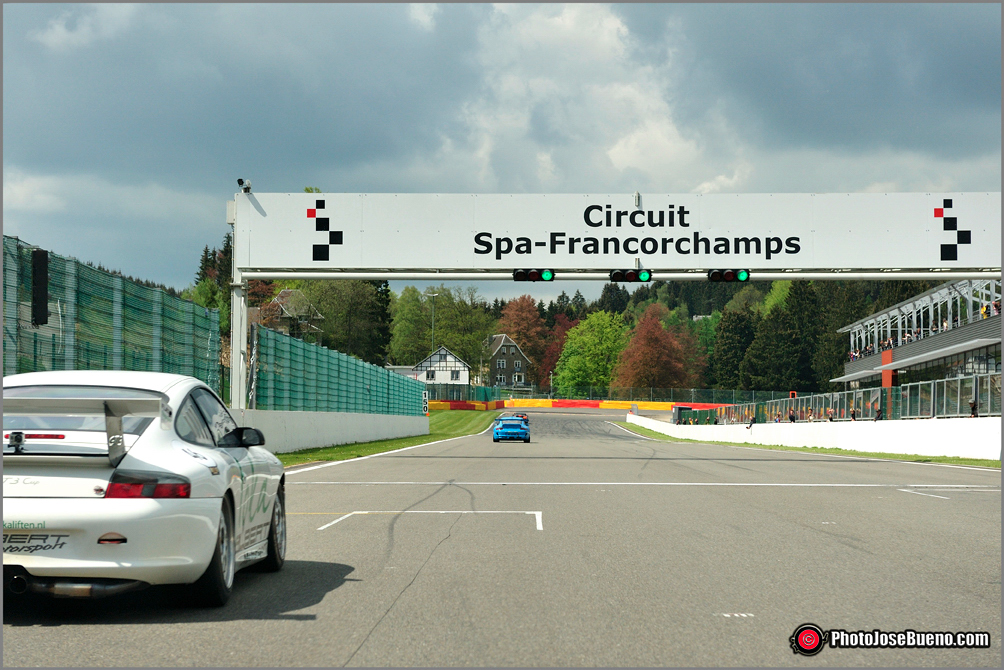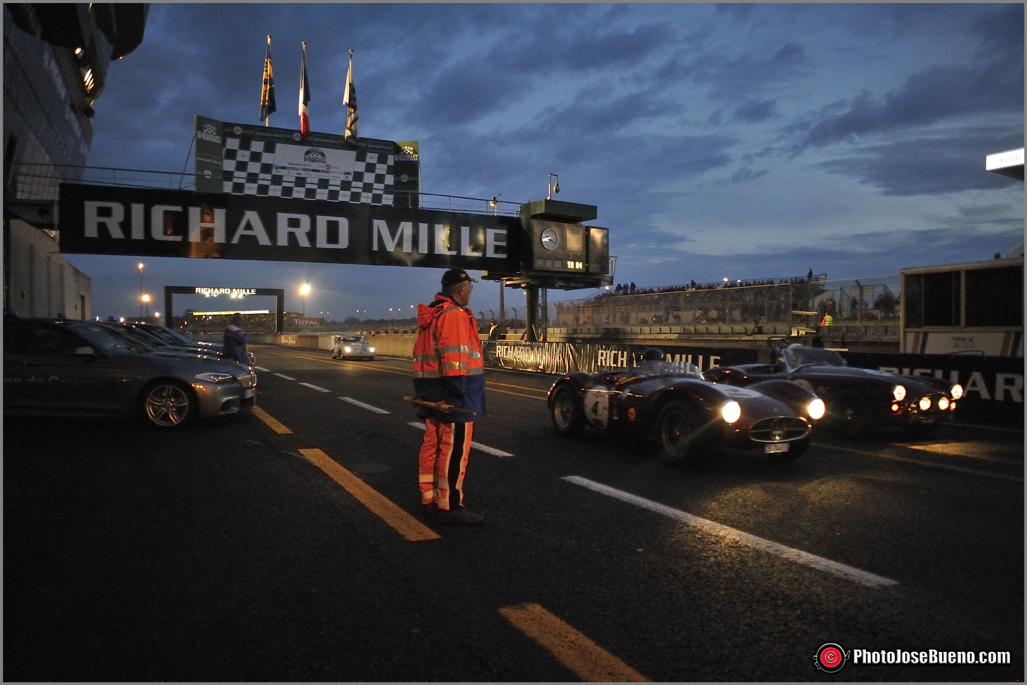
Le Mans Classic – Nikon D700 – Nikkor 24-70mm. – f:6.3 – 1/30s – ISO 2500
Para dar continuidad a la entrada anterior quiero que me acompañes a los circuitos de velocidad más relevantes de Europa, me refiero al circuito de Spa Francorchamps, el circuito de Nurburgring y Le Mans. He elegido esos tres por ser circuitos muy especiales, al menos para mí, y seguro que para mucha gente por su historia.
Son miles las fotos que he realizado en estos y otros circuitos y por tanto me creo con experiencia y capacitado para relatar con sumo agrado como suelo organizar mi trabajo. Debido a la extensión he preferido dividir esta entrada, empezando con los angulares y próximamente trataremos los teles.
Alguno puede pensar que eso de ir a un circuito con un gran angular es raro pero si te fijaste en las pistas comentadas en la entrada anterior del equipo que suelo utilizar cuando acudo a los circuitos, es posible que compartas mi opinión en cuanto a que es una óptica que no puedes olvidar.
Si tuviese que elegir un solo objetivo angular para llevar en mi bolsa, sin duda sería el zoom Nikkor 24-70mm. f:2.8. Este es un objetivo que prácticamente está soldado a uno de mis cuerpos y es que esa focal que empieza en un angular generoso como es el 24mm. y termina en un tele corto, sirve para un alto porcentaje de fotos que realizaremos tanto en la zona de paddock (zona reservada a los participantes de una prueba automovilística) así como en ciertas zonas del circuito que queremos ambientar o destacar.
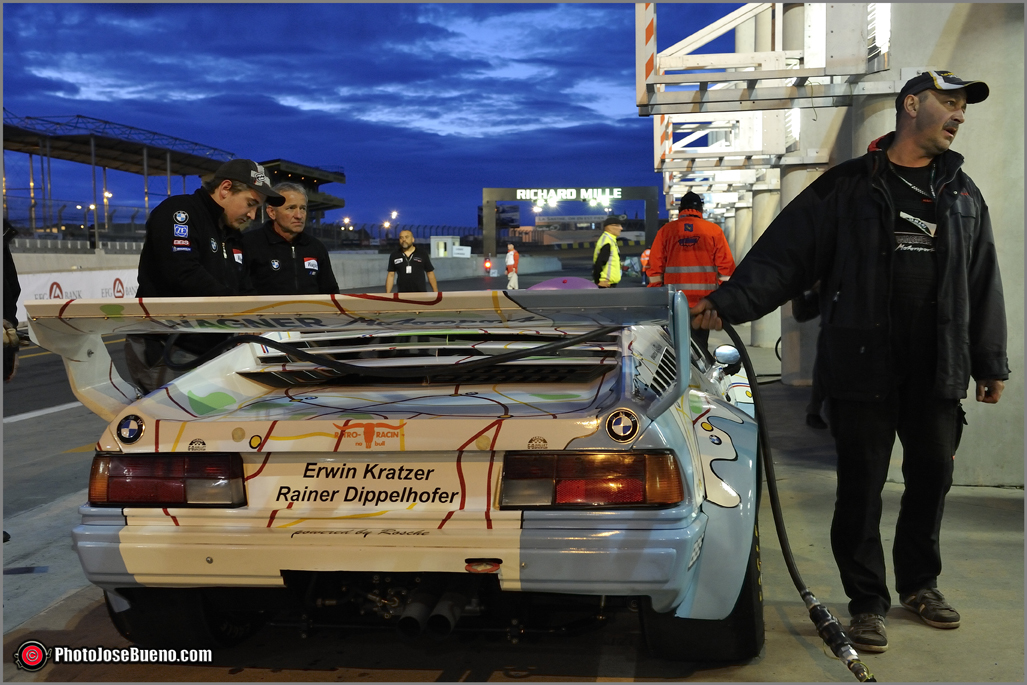
Le Mans Classic – Nikon D700 – Nikkor 24-70mm. – f:5.6 – 1/30s ISO 2500
Cuando estás en esta zona de paddock, normalmente reservada a profesionales por su peligrosidad, siempre hay que estar atento no solo a las numerosas imágenes que ofrece una prueba automovilística si no también a todo lo que nos rodea pues la entrada y salida de coches es continua y a veces peligrosa. Recuerdo en una ocasión que por desconocimiento me acerqué a una zona de repostaje para tomar esas interesantes instantáneas, en cuanto disparé la primera foto con mi gran angular, acudió un comisario muy enfadado para decirme que no podía hacer eso. Efectivamente las cámaras actuales al ser todo electrónica, no es lo mejor para utilizar en una zona llena de gases producidos por la gasolina. Mil disculpas y lección aprendida. Esas tomas siempre las realizo con un teleobjetivo aun que sea corto ya en una zona donde no haya problemas y que mi cámara actúe de mecha.
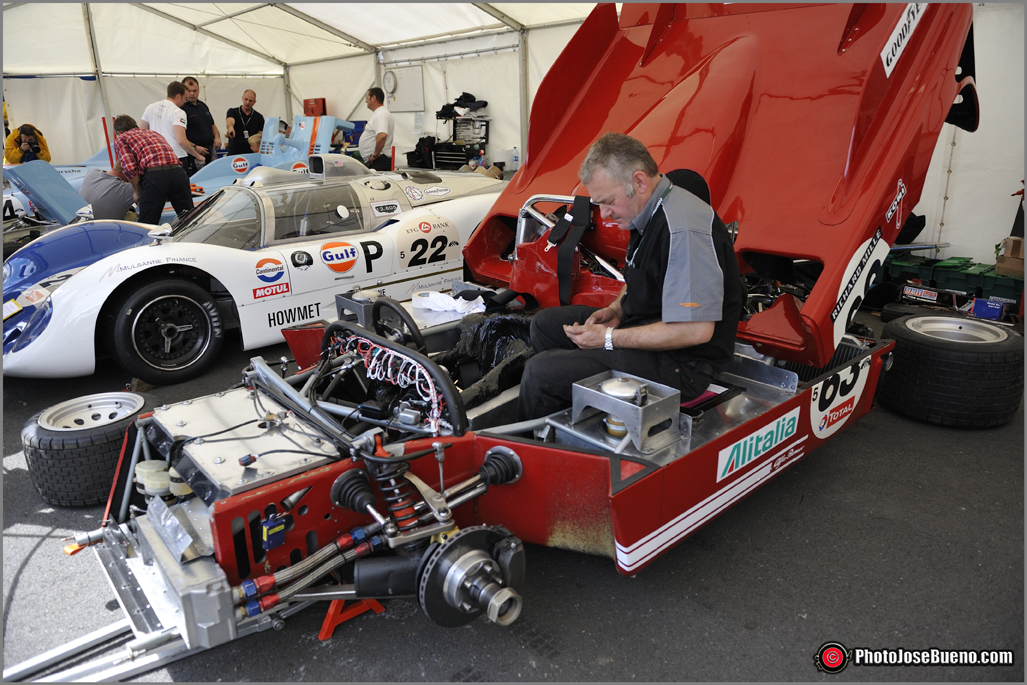
Le Mans Classic – Nikon D700 – Nikkor 24-70mm. – f:3.5 – 1/2500s – ISO 800
Tampoco es aconsejable la fotografía muy intrusiva. Me explico, cuando trabajas con los angulares, en ocasiones tendrás que acercarte mucho a un mecánico o piloto. Pues bien en esas circunstancias el 24-70mm. es perfecto pues en lugar de insistir con 24mm. haremos zoom y utilizamos la focal necesaria para hacer la foto con el encuadre que necesitamos pero sin molestar.
Otro objetivo que me gusta llevar es el Nikkor 14-24mm f:2.8 . Es un zoom gran angular que en la parte más baja 14mm. deforma la imagen pero es el típico objetivo que utilizaremos poco pero cada imagen marca la diferencia precisamente por sus tomas “imposibles” y efectos que genera el casi ojo de pez o mejor dicho super gran angular.
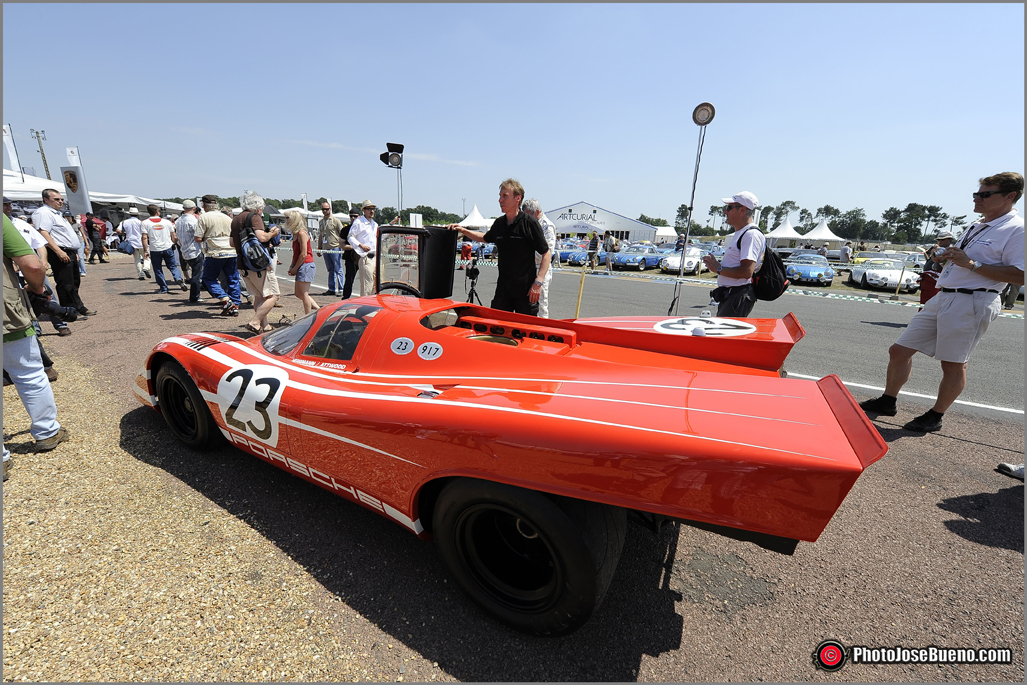
Le Mans Classic – Nikon D700 – Nikkor 14-24mm.
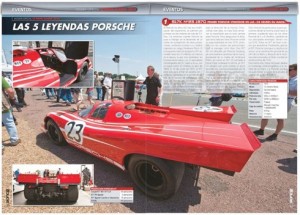
Publicación en la revista 9ONCE Plus
Recuerdo una ocasión en el circuito de Le Mans en la que se celebraba las Le Mans Classic, la marca Porsche sacó el mítico 917, con el que la marca obtuvo sus primeras victorias en las 24 horas de Le Mans. Pues bien se armó tal revuelo que los que estábamos acreditados como prensa, apenas teníamos espacio para hacer nuestro trabajo. Sin dudarlo cambié el 24-70mm por el 14-24mm. y obtuve varias imágenes impresionantes y precisamente una de las revistas para las que trabajo, publicó a doble página una de esas imágenes. Lo mejor fue la respuesta de los lectores felicitando a la revista por el artículo en general y por esa foto en particular.
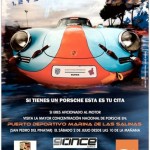
Cartel PDM
Es cierto que este objetivo lo compré para realizar un trabajo que nada tiene que ver con los coches ya que fue para realizar unas 30 imágenes de cocinas para una famosa urbanización. Un día estando en el paddock del circuito del Jarama, vi un coche clásico y se me ocurrió hacer una foto de su frontal. He de reconocer que me encantó su encuadre y desde entonces lo utilizo pero sin abusar.

Foto pintura José Bueno
Por cierto esa foto la utilicé para realizar una de mis foto-pinturas, una técnica que puedes ver en mi página web. Además esa misma foto-pintura fue utilizada en un cartel de un evento de coches.
También es un lujo realizar tu trabajo dentro de un coche de competición. Ya se que esto no está al alcance de todo el mundo pero si alguna vez tienes la oportunidad no la desperdicies, pero te advierto que no es nada fácil trabajar en un habitáculo tan pequeño, rodeado de la jaula antivuelco y atado con cinturones arneses de varios puntos. He de reconocer que soy una persona afortunada ya que este tipo de fotografías las he podido realizar en numerosas ocasiones con amigos pilotos. Pero ojo además de lo incómodo que es el habitáculo, tendrás que contar con la dura suspensión de este tipo de coches y por supuesto debes estar acostumbrado a rodar en un circuito donde todo pasa muy deprisa. No olvides llevar una bolsa por si te mareas y si es así olvídate de las fotos.
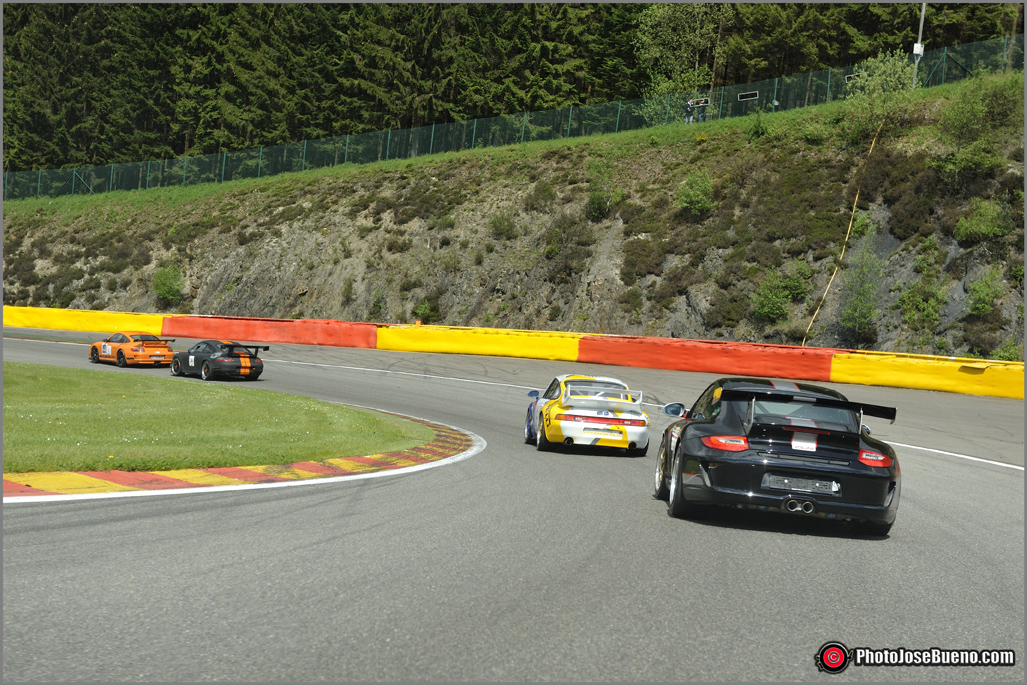
Realizada desde un Porsche Cup. Circuito Spa Francorchamps Nikon D700 – Nikkor 24-70mm. – f:6.3 – 1/400s – ISO 1250
En mi caso suelo trabajar en modo live view, con altas ISO para tener unas velocidades altas y así evitar las trepitaciones, con el Nikkor 24-70mm., un objetivo muy versátil que te permitirá realizar imágenes de otros participantes con sus coches en pleno apoyo o imágenes de un sitio mítico como la famosa bajada Eao Rouge, la subida al Raidillon del circuito de Spa Francorchamps, pero tranquilo que ya llegamos a la meta.
Otro objetivo que además es un gran angular puro y duro que a veces utilizo es el Carl Zeiss 25mm. f:2.8. Un objetivo de focal y que tiene dos grandes virtudes, el color que generan sus fotos y la posibilidad de enfoca desde 1.7 cm. , de hecho hay que tener cuidado pues puedes golpear con el filtro que lleva puesto u el primer plano. Es una óptica a la vieja usanza con enfoque manual pero al ser angular es muy fácil trabajar con el si utilizas el enfoque por hiperfocal. ¿Qué no has visto esa sección de mi blog?, pues aquí lo puedes ver.
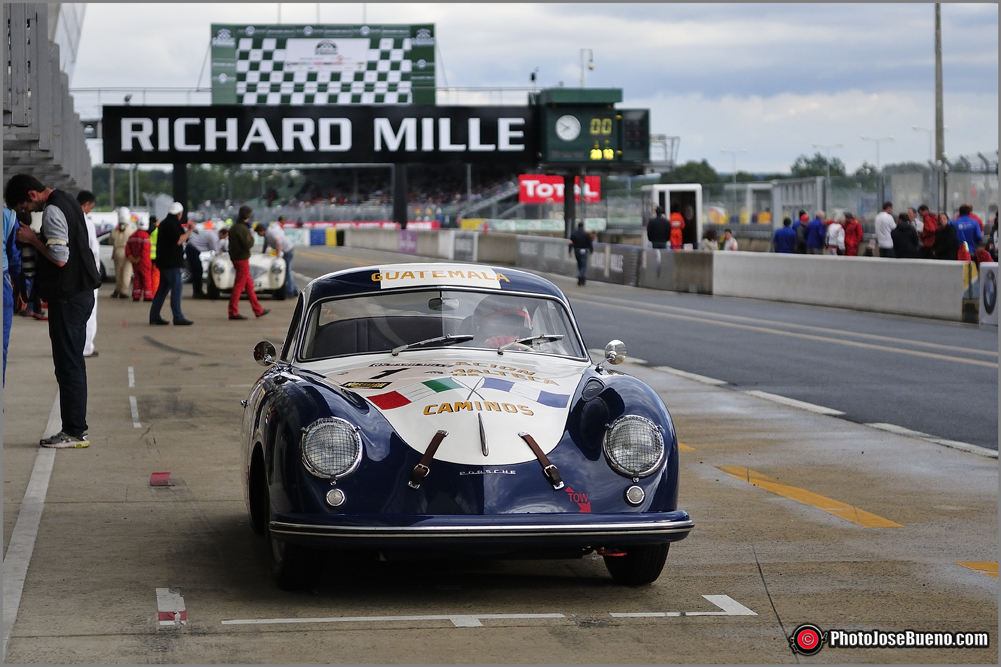
Nikon D300S – Nikkor 24-70mm. – f:2.8 – 1/3200s – ISO 800
Es cierto que alguna vez he utilizado el gran angular en una cámara con formato DX como la Nikon 300S pero no me gusta convertir el 25mm. en un 38mm. con lo que es peor angular. Además la calidad es inferior a las de sensor full frame. Actualmente ya no dispongo de ninguna réflex DX pues como ya explicaré en la siguiente entrada prefiero otros métodos que el factor multiplicador.
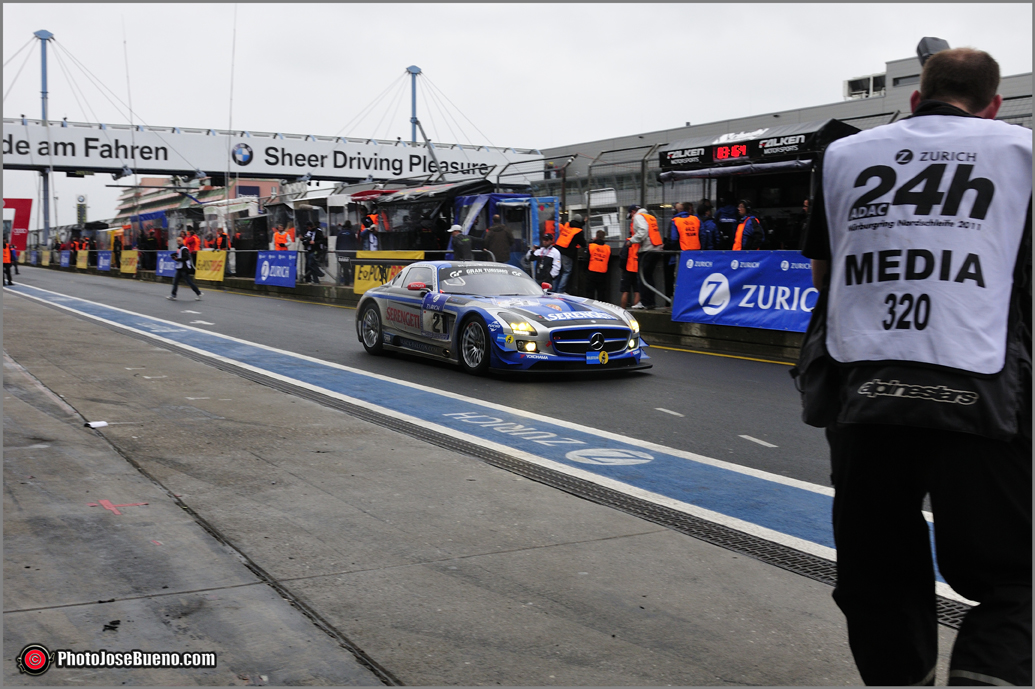
24h. de Nürburgring – Nikon D300S – Nikkor 24-70mm. – f:8.0 – 1/320s – ISO 400
Pero, ¿cómo se trabaja con un gran angular en un circuito?, ¿se pueden hacer barridos?, además de la zona paddock, ¿en qué otras zonas lo podemos utilizar?. Seguro que se te ocurren más preguntas pero de momento voy a contestar éstas.
Por supuesto que cuando se trabaja con un gran angular, tanto si es autofocus con manual, el enfoque es menos crítico que con un teleobjetivo además de tener menos trepitación. Dicho esto cuando el angular es autofocus, suelo utilizar el enfoque puntual y a continuación encuadro. Hay quién prefiere tener disociado el enfoque del disparador y así utilizar el enfoque contínuo pero en mi opinión además de gastar más batería, haremos trabajar inútilmente los motores de enfoque del objetivo y eso se traduce en un mayor desgaste. Cuando el gran angular es manual, suelo utilizar el sistema hiperfocal (si desconoces este sistema te aconsejo visites la página que dediqué es ese tema) o bien enfocar de manera manual a primeros planos y diafragmas abiertos.
Respecto a los barridos, por supuesto que es posible si bien resulta interesante estar cerca de donde pasan los coches y eso no siempre es posible. Además es más fácil hacer el seguimiento en una curva por la velocidad de paso de los coches y también es cierto que resulta más fácil realizar los seguimientos con teleobjetivos pero un buen barrido con un angular te aseguro que no dejará a nadie indiferente.
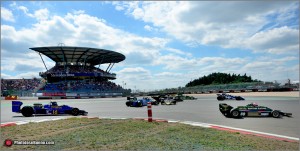
Old Timer Grand Prix circuito de Nürburgring
Nikon D4 – Nikkor 24-70mm. – f:5.6 – 1/2500s – ISO 200
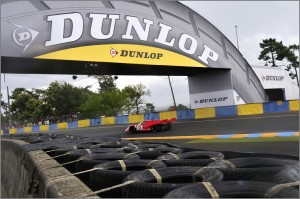
Le Mans Classic – Nikon D300S – Carl Zeiss 25mm. – f:5.6 – 1/500s – ISO 200
Como comentaba al inicio de esta entrada, siempre es conveniente tener alguna foto que ilustre el circuito en el que se desarrolla la prueba. Normalmente cada circuito tiene una zona “mítica” o muy conocida y si en cualquier imagen aparece los coches participantes con esa zona mítica es posible que esa imagen si no vale más que mil palabras, al menos sustituye con seguridad parte del titular del artículo.
Por último quiero recordar que los angulares además de ser más generosos en los enfoques, son mucho más livianos que los pesados teles por lo que no debes olvidar nunca llevar al menos uno en la bolsa, que por cierto la cargaremos con los pesados teleobjetivos en la próxima entrada.
THE CIRCUIT WITH WIDE ANGLE
To give continuity to the previous post I want you to accompany me to the most important race tracks of Europe , I mean the circuit of Spa Francorchamps , the Nurburgring and Le Mans . I chose these three to be very special circuits , at least for me , and certainly for many people because of its history .
There are thousands of pictures I’ve done in these and other circuits and so I think with experience and able to relate with great pleasure as soil organize my work . Because I preferred extension split this post, starting with the angular and try the tele soon .
Some may think that going to a circuit with a wide angle is rare but if you notice the tracks mentioned in the previous post the team that I use when I go to the track, you may share my opinion as to which is a perspective that can not forget.
If I had to choose a single wide-angle lens to carry in my bag , it would certainly be the Nikkor 24 -70mm zoom . f : 2.8. This is a goal that almost is welded to one of my bodies and that length beginning on a generous corner as is the 24mm . and ends in a short tele , serves a high percentage of photos that will make both the paddock area ( area reserved for the participants of a test car ) as well as in certain areas of the circuit we want mood or highlight .
When you’re in the paddock area , normally reserved for professionals to be dangerous , you should always be alert not only to the many images that offers automotive test but also all around us as the entry and exit of cars is continuous and sometimes dangerous . I remember on one occasion I approached ignorance fueling area to make these interesting snapshots, as the first photo shoot with my wide angle , a commissioner angrily came to tell me I could not do that. Indeed current cameras to be all electronic , it is best to use in an area full of gases produced by gasoline . Apologies and lesson learned. Those shots always performed with a telephoto lens that is short and even in an area where there are no problems and that my camera acts as a wick.
Nor is it advisable very intrusive photography . I mean, when you work with the angular , sometimes you will have to get very close to a mechanic or pilot . Well, in these circumstances the 24 -70mm . is perfect because instead of insisting on 24mm . we use the zoom and focus necessary to take the picture with the frame we need without upsetting .
Another goal I like to wear is the Nikkor 14 -24mm f : 2.8. It is a wide-angle zoom on the 14mm lower . distorts the image but it is the typical target bit but each image use makes a difference precisely because your shots «impossible» and general effects almost fisheye or rather super wide angle .
I remember one time in the Le Mans circuit in which was held the Le Mans Classic , the brand took the legendary Porsche 917, with which the brand got its first victories in the 24 Hours of Le Mans . Well they made such a fuss that we were accredited as press, hardly had space to do our job. Without hesitation I changed the 24 -70mm by 14 -24mm . and got several stunning images and precisely one of the magazines I work , published a double page one of those images . The best part was the response from readers congratulating the magazine article in general and this particular photo .
It is true that this objective I bought to do a job that has nothing to do with cars as it was for about 30 pictures of kitchens for a famous urbanization. One day at the Jarama circuit paddock , I saw a classic car and I happened to take a picture of your face . I must admit that I loved the frame and since then I use but not abused.
By the way I used that picture for one of my photo- paintings, a technique that you can see on my website . Also that same photo- painting was used on a poster of a car event .
It is also a luxury to do your job in a racing car . I know this is not available to everyone but if you ever have the opportunity to not waste it , but I warn you it is not easy to work in a space so small, surrounded by the roll cage and harness belts tied with several points. I must admit that I am a lucky person because this kind of photography I have been able to perform on numerous occasions with pilot friends . But besides eye how uncomfortable it is the interior , you have to have the hard suspension of these cars and of course you must be used to shoot at a circuit where everything happens so fast. Do not forget to bring a bag if you get dizzy and if so forget about the photos .
In my case I usually work in live view mode with high ISO to have a high speed and avoid the trepitaciones , with the Nikkor 24 -70mm . , A versatile lens that lets you images of other participants with their cars in full support or images of a mythical place known as Rouge Eao down , rising to Raidillon Spa Francorchamps circuit , but quiet as we reach the goal .
Another objective is also a hard-nosed Wide sometimes use is the Carl Zeiss 25mm . f : 2.8. A prime lens and has two great virtues , the color generated by their pictures and the ability to focus from 1.7 cm . Actually have to be careful because you can hit with the filter wears or the foreground. It is an old-fashioned optical manual focus but being angle is very easy to work with if you use hyperfocal approach . What you have not seen this section of my blog? , Because here you can see it .
It is true that I have ever used the wide angle on a DX format camera like the Nikon 300S but I hate converting 25mm . by 38mm. with angular worse . Furthermore, the quality is less than the full frame sensor . Currently and I do not have any DX SLR because as I will explain in the next post I prefer other methods the multiplier.
But how do you work with a wide angle in a circuit? , Can you make sweeps ? , Besides the paddock area , what other areas can we use it ? . Sure you can think of more questions but for now I will answer them.
Of course, when working with a wide angle , whether autofocus with manual focus is less critical than with a telephoto lens having less trepitación well . Having said that when the angle is autofocus, I use the spot focus and then encuadro . There are those who prefer to have dissociated trigger approach and then use the continuous approach but in my opinion well spend more battery , we work unnecessarily lens focus motors and that means more wear . When the wide angle is manual, I use hyperfocal system (if not know this system I suggest you visit the page that is dedicated that subject ) or manually focus close-ups and large apertures .
Regarding sweeps , of course it is possible although it is interesting to be near where passing cars and that is not always possible . It is also easier to track on a curve by the speed of passing cars and it is also true that it is easier to make follow-ups with telephoto lenses but a good sweep with a angle I promise you will not leave anyone indifferent.
As mentioned at the beginning of this post , it is always advisable to have a picture that illustrates the circuit in which the test is developed . Typically each circuit has an area » mythical» or well known and if at any participating cars image appears with this mythical area is possible that image if not worth a thousand words, at least safely replace the holder of the article.
Finally, I recall that the angular besides being more generous in approaches , are much lighter than the heavy TVs so you must never forget to bring at least one bag , which incidentally the charge with heavy telephoto lenses in the next entry.
